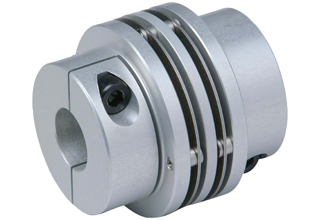Disk couplings come in two variations, a single disc and a double disc. Single disc couplings are composed of two hubs, typically made of aluminum or stainless steel, and a single, flat, stainless steel disk spring. Double disk couplings are also made up of two hubs, but feature an additional spacer sandwiched between two disk springs. This spacer can be made of the same material as the hubs, but can also be made with electrically isolating materials.
Beyond appearance, the difference between these two types is how they handle shaft misalignment. A single disc coupling cannot accommodate parallel misalignment because of the flexing limitations of the lone disk, but the duel disc springs of the double disk coupling allow it to flex in different directions.
This flexibility, however; does have a down side. While the coupling is suited for high speed applications, it is also more fragile than most other couplings. The disk springs can be easily bent out of shape, meaning the coupling can only handle low bearing loads.
